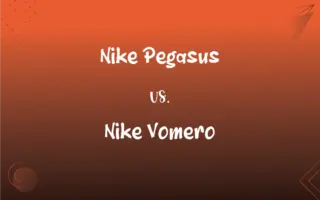Shuttle Vector vs. Expression Vector: What's the Difference?
Edited by Aimie Carlson || By Harlon Moss || Published on February 6, 2024
A shuttle vector is a DNA molecule used for transferring genetic material between different host cells, while an expression vector is designed to express a specific gene in a target cell.

Key Differences
A shuttle vector is uniquely characterized by its ability to replicate in two or more different host species, making it versatile for genetic experiments across various organisms. In contrast, an expression vector is specifically tailored to produce proteins by expressing genes within a particular host cell, focusing on efficient gene expression in that specific environment.
Shuttle vectors are primarily used for the transportation and manipulation of DNA between different biological systems. They are essential in biotechnological applications that require gene cloning across diverse species. On the other hand, expression vectors are designed to achieve high-level expression of a particular gene, mainly for protein production or gene function studies within a single species.
The construction of a shuttle vector involves incorporating origins of replication compatible with multiple host species, ensuring its functionality in different cellular environments. Expression vectors, however, are engineered with strong promoters and other regulatory elements to optimize the expression of the inserted gene in the chosen host.
In research, shuttle vectors are invaluable for gene cloning and subcloning, allowing scientists to work across various genetic systems seamlessly. Expression vectors, in contrast, are fundamental in protein expression studies, gene therapy, and vaccine development, providing a platform for expressing genes under controlled conditions.
Shuttle vectors must contain elements that allow replication and selection in multiple hosts, such as antibiotic resistance genes for different species. Expression vectors, however, are equipped with specific promoters, enhancers, and often tags for protein purification, tailored to the expression needs of the target host cell.
ADVERTISEMENT
Comparison Chart
Function
Transfers genes between different hosts
Expresses genes within a specific host
Host Range
Compatible with multiple host species
Optimized for a particular host species
Primary Use
Gene cloning and manipulation across species
High-level gene expression and protein production
Key Features
Multiple origins of replication, broad host range
Strong promoters, regulatory elements for expression
Research Application
Gene transfer, cloning, subcloning
Protein expression, gene function studies
ADVERTISEMENT
Shuttle Vector and Expression Vector Definitions
Shuttle Vector
A shuttle vector acts as a vehicle for gene cloning in diverse organisms.
The new shuttle vector proved effective in cloning genes from humans to bacteria.
Expression Vector
An expression vector is engineered for optimal gene function expression in certain cell types.
To study the gene's role in immunity, a specific expression vector was used in immune cells.
Shuttle Vector
A shuttle vector facilitates the movement of genes across different biological systems.
The scientist employed a shuttle vector to transfer the modified DNA sequence into plant cells.
Expression Vector
An expression vector contains regulatory elements for targeted gene expression.
The designed expression vector ensured high-level expression of the therapeutic gene in mammalian cells.
Shuttle Vector
A shuttle vector is a plasmid or viral DNA used to transfer genetic material between different organisms.
The shuttle vector was used to clone the gene from yeast to E. coli.
Expression Vector
An expression vector is a DNA construct designed for gene expression in a specific host cell.
The lab used an expression vector to produce insulin in bacterial cells.
Shuttle Vector
Shuttle vectors are tools in molecular biology for cross-species genetic manipulation.
Using a shuttle vector, the research team successfully introduced the fish gene into a fungal genome.
Expression Vector
Expression vectors facilitate the production of large quantities of specific proteins.
By employing an expression vector, the team synthesized the enzyme in yeast cells.
Shuttle Vector
Shuttle vectors are designed to replicate in multiple host species for versatile genetic engineering.
Our lab utilized a shuttle vector to study gene function in both bacterial and mammalian cells.
Expression Vector
Expression vectors are key tools in recombinant protein production and gene therapy.
The new expression vector was crucial for the success of the gene therapy trial.
FAQs
What is a shuttle vector?
A shuttle vector is a DNA molecule that can replicate in multiple host species, used for transferring genes between different organisms.
How does a shuttle vector work?
A shuttle vector contains origins of replication for multiple species, allowing it to replicate and function in different host cells.
What is an expression vector?
An expression vector is a DNA construct designed for gene expression within a specific host cell.
Can shuttle vectors be used in any species?
While shuttle vectors are versatile, they are designed for specific host ranges and may not work in all species.
What are common hosts for shuttle vectors?
Common hosts for shuttle vectors include bacteria, yeast, and mammalian cells.
What are typical hosts for expression vectors?
Typical hosts for expression vectors are bacteria, yeast, insect, and mammalian cells, depending on the vector design.
How do expression vectors enhance gene expression?
Expression vectors enhance gene expression through strong promoters and regulatory elements tailored to the host's cellular machinery.
What is the main purpose of an expression vector?
The main purpose of an expression vector is to express a specific gene in a target host, often for protein production.
What are the limitations of shuttle vectors?
Limitations of shuttle vectors include host range specificity and potential stability issues in some hosts.
What are the limitations of expression vectors?
Limitations of expression vectors include the need for specific regulatory elements for different hosts and potential issues with high-level expression causing cell stress.
How do shuttle vectors aid in cross-species research?
Shuttle vectors allow genes to be easily transferred and studied across different species, facilitating cross-species genetic research.
Can shuttle vectors carry large DNA inserts?
Shuttle vectors can carry large DNA inserts, but the size capacity depends on the vector design and host compatibility.
Are expression vectors species-specific?
Yes, expression vectors are often optimized for specific species to ensure efficient gene expression.
What makes shuttle vectors unique in genetic engineering?
Their ability to function in multiple species makes shuttle vectors unique and versatile in genetic engineering.
Are expression vectors used for cloning?
Expression vectors can be used for cloning, but their main function is to express the cloned gene.
How are expression vectors used in medicine?
Expression vectors are used in medicine for protein drug production, gene therapy, and vaccine development.
Can shuttle vectors be used for protein production?
While shuttle vectors can be used for protein production, they are primarily designed for gene transfer and cloning.
Can expression vectors carry multiple genes?
Some expression vectors can carry multiple genes, but this may require specialized design to ensure proper expression.
Are shuttle vectors safe for therapeutic use?
The safety of shuttle vectors for therapeutic use depends on their design and the specific application.
Are expression vectors used in gene editing?
Expression vectors can be used in gene editing to express nucleases or other components necessary for the editing process.
About Author
Written by
Harlon MossHarlon is a seasoned quality moderator and accomplished content writer for Difference Wiki. An alumnus of the prestigious University of California, he earned his degree in Computer Science. Leveraging his academic background, Harlon brings a meticulous and informed perspective to his work, ensuring content accuracy and excellence.
Edited by
Aimie CarlsonAimie Carlson, holding a master's degree in English literature, is a fervent English language enthusiast. She lends her writing talents to Difference Wiki, a prominent website that specializes in comparisons, offering readers insightful analyses that both captivate and inform.































































